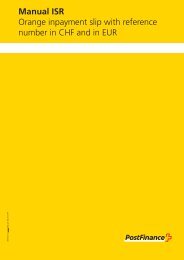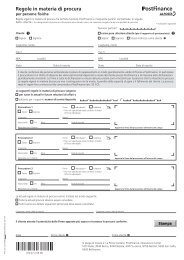Manual E-bill 499.41
Manual E-bill 499.41
Manual E-bill 499.41
Create successful ePaper yourself
Turn your PDF publications into a flip-book with our unique Google optimized e-Paper software.
12.5 Bill data<br />
12.5.1 yellow<strong>bill</strong> Invoice (input)<br />
yellow<strong>bill</strong> Invoice is the standard format for structured <strong>bill</strong> data and describes<br />
both the syntax and structure of electronic <strong>bill</strong>s (XML files). The format is<br />
based on the swissDIGIN standard (see section 12.5.7).<br />
The main elements when sending the XML file are the “Header” and the<br />
“Body” (see diagram below). The “Header” contains mainly internal yellow<strong>bill</strong><br />
system control data. The main contents are defined in the “Body”.<br />
Graphical representation of XML yellow<strong>bill</strong> Invoice<br />
• The “Body” consists of the elements “DeliveryInfo”, “Bill”, “Payment-<br />
Data”, “BillPresentment” and “Appendix”.<br />
• The elements “DeliveryInfo” and “BillPresentment” contain specific<br />
key data for the yellow<strong>bill</strong> system such as the unique number of the <strong>bill</strong>er<br />
(BillerID) or control data for <strong>bill</strong> presentment.<br />
• The main <strong>bill</strong> content is in the “Bill” element. This element in turn is<br />
divided – similar to a paper <strong>bill</strong> – into the elements “Header” (address data<br />
of <strong>bill</strong> recipient and issuer), “LineItems” (<strong>bill</strong> line items as on a paper<br />
<strong>bill</strong>) and “Summary” (summary per VAT rate). IMPORTANT: For processing<br />
unsigned <strong>bill</strong>s, the element “Bill” can be omitted.<br />
• The “PaymentData” element contains the ISR data (ISR elements) and the<br />
unique <strong>bill</strong> recipient’s subscriber number for e-<strong>bill</strong> (EBillAccountID). The<br />
“PaymentType” field indicates whether it is a <strong>bill</strong> (“ESR”), credit (“CREDIT”)<br />
or a <strong>bill</strong> detail for Debit Direct payments (“DD”). The “Instalment” element<br />
can be used to define instalments.<br />
<strong>Manual</strong> E-<strong>bill</strong> Version October 2010 48/64

















